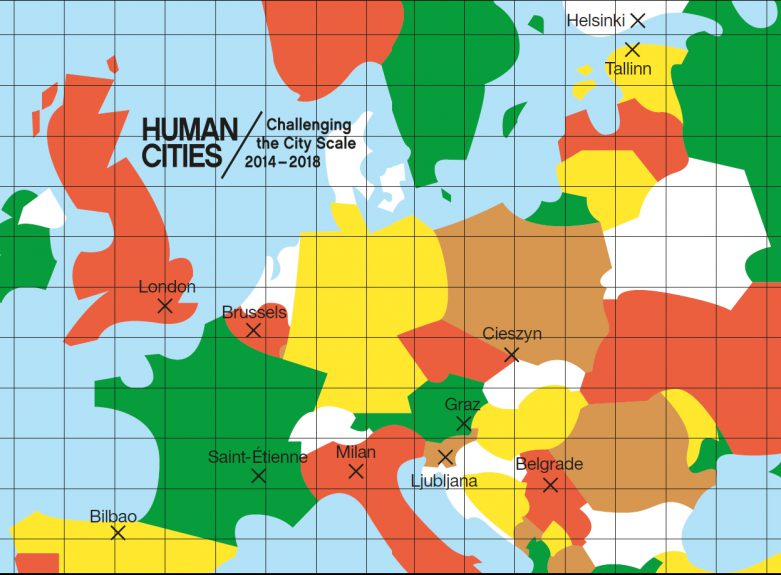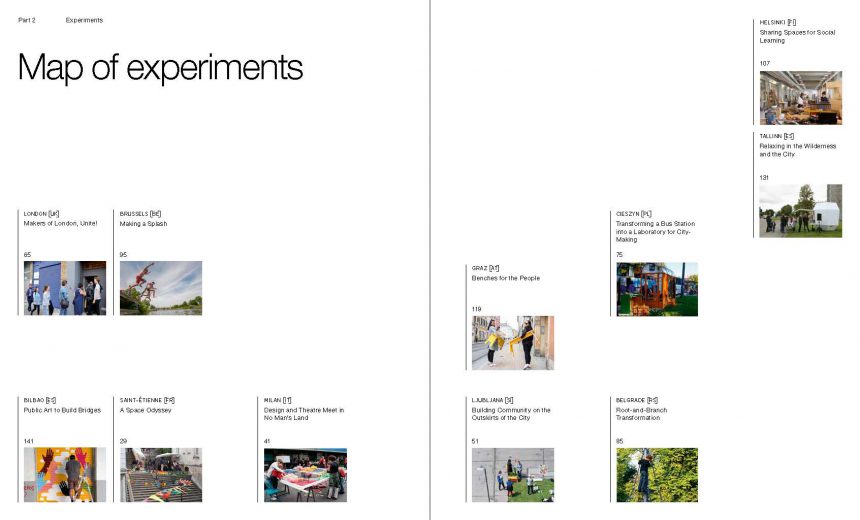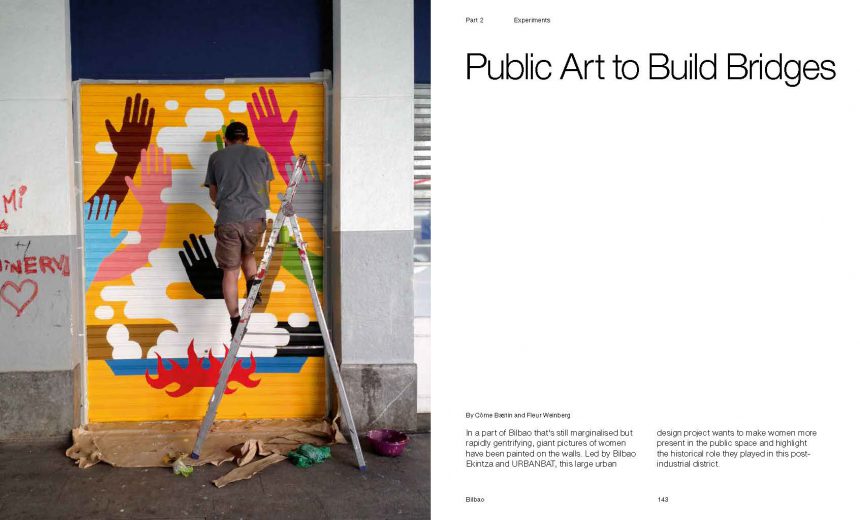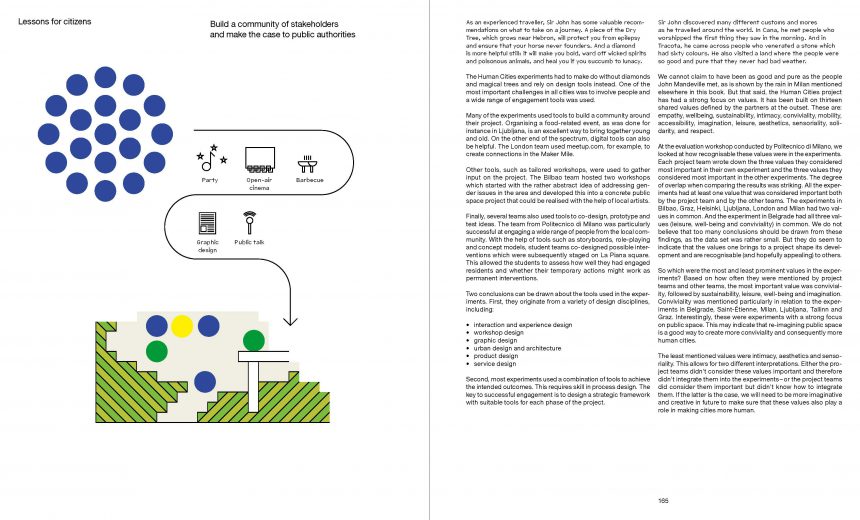A survey on emerging convivial design in a human scale city
During the European programme Human Cities_Challenging the City Scale, the Cité du design, lead partner, has chosen to put the spotlight on different projects undertaken by the inhabitants of its own city.Human Cities programme, which by the end of its survey, was no longer questioning the effects of scale leading to interactions between the actors, but a form that was gradually revealed as the survey progressed: the mesh.
The book “Maillages” (Meshes) consists of a review of experiences and experiments . It is a survey made by the designer Magalie Rastello who interviewes the collectives that were active in Saint-Étienne during the Human Cities project. Her work is completed by structuring commentaries by the heads of the programme at the Cité du Design (Josyane Franc, Camille Vilain, Olivier Peyricot and Nathalie Arnould), all of which has been editorialised by Victoria Calligaro, with the unwavering support of the associations and collectives and, finally, some reflective contributions from Raymond Vasselon.
A survey on emerging convivial design in a human scale city by Cité du design Saint-Etienne
Read the book : Maillages_web_planches_BD
A city is an entity in perpetual movement that is permanently evolving. Whether these transformations are minute, gigantic, discrete, ostentatious, brutal or progressive, their implementation involves several scales of organisation and different processes. Big events can sometimes radically change the face of a city for a few days, but the deeper changes are often those that set in over the time it takes to carry out urban development and major renovation projects. Cities are also subject to other types of changes, whose timescales vary and which are initiatives of inhabitants and voluntary sector actors who wish to act on their everyday environment.
During the European programme Human Cities_Challenging the City Scale, the Cité du design, lead partner, has chosen to put the spotlight on different projects undertaken by the inhabitants of its own city.
As the Human Cities_ Challenging the City Scale programme has sought to show throughout its course, the stakeholders grappling with the challenge of the urban transformations give their projects a strong political and experimental dimension.
Human Cities programme, at its final phase, was no longer questioning the effects of scale leading to interactions between the actors, but a form that was gradually revealed as the survey progressed: the mesh.
This perspective opens up a space for possibilities that gives structure to the actors’ feelings of connections between them, linking to their multiple realities. The effective life of a city is made up of meshes and binders, tenuously linking the entire territory in one and the same net, which encompasses everything in a single living environment, including the institutions, the official producers of the urban, but also residents, their imaginations, their actions, human and non-human.
As the Human Cities European programme comes to its end, we can say that the focus on one city – Saint-Etienne – and the local actions that we know so well has enabled us to get our feet back on the ground. Maillages (Meshes) proposes to draw out of the Saint-Étienne situation an exemplary structuring of citizens’ initiatives, which, over the last decade, have given the city a remarkable identity: the medium- sized city claimed as a space on the right scale, ideal to produce resilience, a city on a human scale.
Maillages (Meshes) consists of a review of experiences and experiments . It is a survey made by the designer Magalie Rastello who interviewed the collectives that were active in Saint-Étienne during the Human Cities project. Her work is completed by structuring commentaries by the heads of the programme at the Cité du Design (Josyane Franc, Camille Vilain, Olivier Peyricot and Nathalie Arnould), all of which has been editorialised by Victoria Calligaro, with the unwavering support of the associations and collectives and, finally, some reflective contributions from Raymond Vasselon.
Since 2014, the Human Cities network has been working on Challenging the City Scale to question the urban scale and investigate cocreation in cities. The Human Cities partners have carried out urban experimentations in 11 European cities empowering citizens to rethink the spaces in which they live, work and spend their leisure time.
Challenging the City Scale, journeys in People-Centred Design is the final book of the project. Through conversations with people involved, the book examines how bottom-up processes and their design, tools and instruments generate new ideas to reinvent the city. It offers inspiration and insights to everyone, from practitioners and politicians to designers and active citizens, eager to try out new ways to produce more human cities together.
Title : Challenging the City Scale, Journeys in People-Centred Design
Collective book co-edited by: Olivier Peyricot, Josyane Franc, Frank Van Hasselt
Authors: Josyane Franc, Olivier Peyricot, John Thackara, Alice Holmberg, Côme Bastin, Fleur Weinberg, Anya Sirota, Frank Van Hasselt, Robin Houterman
Graphic design: Audrey Templier, Isabelle Daëron Language: English Publisher and distributor: Birkhäuser, Basel
Co editors : Cité du design (Saint-Etienne) et Clear Village (Londres) ISBN: 978-3-0356-1796-2 Format : 21,5 x 26 cm (vertical)– 176 p Price: 39.95 € Available in partner’s bookshops and bookshop distributed by Birkhäuser Open access digital version: https://www.degruyter.com/view/product/510323?format=EBOK
As cities organizations are facing major urban and technological transformations, European citizens are taking possession of their cities, collaborating or acting for its renewal. Which kind of tools are set up to think and produce the public space together? How to make these bottom-up initiatives sustainable?
Challenging the City scale 2014-2018 / Investigation is a collaborative research work of Human Cities project, made from more than 80 case studies collected by the partners in Europe. They tell about actions led by creative citizens to transform their urban environment. Researchers from Cité du design Saint-Étienne, the Department of Design of Politecnico di Milano and Urban Planning Institute of The Republic of Slovenia Ljubljana provide a state of the art of these initiatives. Analysing these multiple examples, they investigate how urban dwellers participate, get organized and collaborate with creative professionals to prototype more liveable cities.
This scientific work published by Cité du design Saint-Étienne is addressed to researchers, practitioners, but also developers or creative citizens.
Title: Human Cities / Challenging the City Scale 2014-2018 / Investigation Main authors: Cité du design Saint-Etienne: Isabelle Daëron, Floriane Piat & Eléa Teillier Design Departement, University Politecnico di Milano: Davide Fassi & Laura Galluzzo Urban Planning Institute of the Republic of Slovenia, Ljubljana: Matej Nikšič, Nina Goršič & Biba Tominc
Language: English Copyright © Cité du design, 2018 ISBN: 978-2-912808-79-0 . Format : 215×260 mm – 240 p – not sold – free distribution within the framework of Creative Europe Programme of the European Union 2014-2018
Special issue of Saint-Etienne Higher School of Art and Design Magazine about Human Cities.
Invited by Cité du design Saint-Étienne to join the Human Cities_Challenging the City Scale European programme, the Images_Récits_Documents team at ESADSE (Saint-Étienne Higher School of Art and Design) has been pondering the notion of the scale of the vision of urban space through photography.
Actually, academic partners of Human Cities were in charge of developing Masterclasses. That’s why the laboratory Images, Narrations, Documents (In French : Images_Récits_Documents — IRD) of the ESADSE has worked for 2 years with ERASMUS and international students on the topic of the scales of urban visions, under the direction of Kader Mokaddem, teacher and co-director of the IRD lab.
The Masterclass relied on the practices of documentary photography developed in the lab’s research programme “Documenter, fictionner un territoire” since 2010. The students and researchers enriched their ideas with the meeting of international speakers and local stakeholders.
This issue of “Occurrence” traces the results of this work.
On 13th September 2018 , during the final event of Human Cities_Challenging the City Scale in Tallinn, happy partners launched a very important common production : the human cities 2014-2018 project book : Challenging the City Scale, journeys in People-Centred Design.

This 176 pages book is released by the famous international publisher Birkhäuser, and co-edited by Cité du design Saint-Etienne and Clear Village London, with the contributions of all the partners and invited authors. After a 1st publication oriented on research and inspirational case studies, this final book is the story of our experiences and cooperation addressed to a large audience of people interested in urban design and practices .
Since 2014, the Human Cities network has been working on Challenging the City Scale to question the urban scale and investigate cocreation in cities. The Human Cities partners have carried out urban experimentations in 11 European cities empowering citizens to rethink the spaces in which they live, work and spend their leisure time. Through conversations with people involved, the book examines how bottom-up processes and their design, tools and instruments generate new ideas to reinvent the city. It offers inspiration and insights to everyone, from practitioners and politicians to designers and active citizens, eager to try out new ways to produce more human cities together.
Our project can be seeen as a journey in people-centred design.
To prepare it, we asked Alice Holmberg, a designer and co-creation expert, to help each partner start their experiment through co-creative sessions. She explains in her article her approach to participatory design, and how she established a co-creation framework that was applied in a variety of contexts.

After the co-creative sessions, each partner departed on their own journey. For example, our partners in Saint-Étienne, Graz, Bilbao, Helsinki and London worked with citizens to turn vacant or
underused spaces into test sites for new solutions for work, service provision, education and communication. In Ljubljana, Belgrade, Cieszyn, Tallinn, Brussels and Milan, our partners joined forces with citizens to contribute to the development of a neighbourhood through improving the quality of public spaces. We invited two journalists, Côme Bastin and Fleur Weinberg, to capture the stories of the experiments in each of the 11 partner cities. These stories compose the main part of this book.

The variety of experiments allowed us to learn from each other. It also gave some hints for citizens, designers, and decision makers (insitutions and developers) which would like initiate that kind of actions. These learnings are shared in the third part of the book, written by Robin Houterman from a collective reflection led by all the partners.

We asked two urban experts to provide a context for our stories. John Thackara, a writer-philosopher, explains the importance of understanding the notion of the city “as a living system”. His chapter emphasises the need to take care of our commons, a term that includes the spaces, memories, knowledge, skills, culture and biodiversity that we all share.
Anya Sirota, founder of and architect at Akoaki, shares with us her experiences from Detroit, USA. In a context of severe urban decline, Akoaki designs architectural interventions, art objects,
and social environments that aim to make an impact far beyond their physical appearances.
As a conclusion – or an introduction to the next journeys to come – Olivier Peyricot and Josyane Franc re-question the topic of bottom-up initiatives in the global context of city making. Could active citizen be the sole driving forces of the tranformations in contemporary cities? How to collectively take responsibility and act for the global challenges facing our urban societies ?
Since its start, the Human Cities project has led to a network of “Human Citizens” distributing their knowledge and skills across Europe, and beyond as well by making use of the network of UNESCO Creative Cities of Design. By writing this book, we hope to expand this network of Human Citizens even further. We hope that by sharing our enthusiasm and experiences, the book will be an inspiration and a valuable reference for those inclined to become involved themselves. Moreover, we want to convince policy and decision makers of the value of these initiatives and inspire them to take action to facilitate them better in the future.